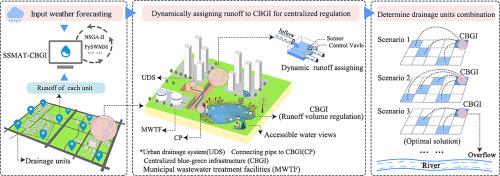开发集中式蓝绿基础设施调控城市径流的决策支持系统
IF 11.2
1区 社会学
Q1 ENVIRONMENTAL STUDIES
引用次数: 0
摘要
不透水地表的扩大和气候变化削弱了城市排水系统,导致城市内涝频发。与分散式绿色基础设施相比,集中式蓝绿基础设施(CBGI)具有更大的存储容量和对未来不确定性的更好适应能力。然而,CBGI与灰色基础设施的整合,以实现智能径流分配和增强UDS弹性,仍未得到充分探索。本研究开发了CBGI智能雨水管理应用程序(SSMAT-CBGI),以支持CBGI动态和自适应的径流分配和存储管理。通过整合空间分析、SWMM和NSGA-II算法,SSMAT-CBGI可以实时模拟和评估不同的径流分配策略,快速响应降雨事件,并通过内置的决策支持工具自动识别最优控制方案。将SSMAT-CBGI应用于陕西省西咸新区中央绿色廊道公园,通过模拟12种场景,评估其在各种不确定条件下的适用性和控制稳定性。随着回归周期从5年增加到50年,UDS的CBGI恢复力保持在0.76以上(总分为1),UDS出口流量峰值降幅最大达到48.69%。即使在未来极端气候和不透水比增加的情况下,CBGI仍然可以调节超过25.93%的排水单元径流。SSMAT-CBGI具有直观的用户界面,使利益相关者能够表达他们的关注点和偏好,同时还支持实时更新和结果可视化。本文章由计算机程序翻译,如有差异,请以英文原文为准。

Developing a decision support system for regulating urban runoff by centralized blue-green infrastructure
The expansion of impervious surfaces and climate change have weakened urban drainage systems (UDSs), resulting in frequent urban waterlogging. Compared to decentralized green infrastructure, centralized blue-green infrastructure (CBGI) offers greater storage capacity and better adaptability to future uncertainties. However, the integration of CBGI with gray infrastructure for intelligent runoff assignment and enhanced UDS resilience remains underexplored. This study develops a Smart Stormwater Management ApplicaTion for CBGI (SSMAT-CBGI) to support dynamical and adaptive runoff assignment and storage management for CBGI. By integrating spatial analysis, SWMM, and the NSGA-II algorithm, SSMAT-CBGI can simulate and evaluate different runoff assignment strategies in real time, respond rapidly to rainfall events, and automatically identify optimal control solutions through built-in decision support tools. SSMAT-CBGI was applied to the Central Green Corridor Park in Xixian New Area, Shaanxi Province, China, to evaluate its applicability and control stability under various uncertainty conditions by simulating twelve scenarios. As the return period increased from 5- to 50year, the UDS resilience with CBGI remained above 0.76 (out of 1), and the maximum reduction in peak outflow at the outlet of UDS reached 48.69 %. Even under climate extremes and increased impervious ratio in the future, CBGI can still regulated over 25.93 % of the runoff from drainage units. SSMAT-CBGI with intuitive user interface enables stakeholders to express their concerns and preferences, while also supporting real-time updates and result visualizations.
求助全文
通过发布文献求助,成功后即可免费获取论文全文。
去求助
来源期刊

Environmental Impact Assessment Review
ENVIRONMENTAL STUDIES-
CiteScore
12.60
自引率
10.10%
发文量
200
审稿时长
33 days
期刊介绍:
Environmental Impact Assessment Review is an interdisciplinary journal that serves a global audience of practitioners, policymakers, and academics involved in assessing the environmental impact of policies, projects, processes, and products. The journal focuses on innovative theory and practice in environmental impact assessment (EIA). Papers are expected to present innovative ideas, be topical, and coherent. The journal emphasizes concepts, methods, techniques, approaches, and systems related to EIA theory and practice.
 求助内容:
求助内容: 应助结果提醒方式:
应助结果提醒方式:


